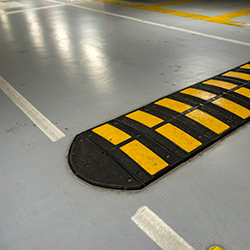Speed bumps and humps serve similar purposes but differ significantly in their design and impact on traffic. Speed bumps are abrupt and high, making them more suitable for low-speed areas such as parking lots and driveways. In contrast, speed humps are gradual and spread out, designed to slow down vehicles over a longer distance, which makes them ideal for residential streets.
- Speed bumps typically range from 3 to 6 inches in height and extend 1 to 3 feet across the road.
- Speed humps are generally 3 to 4 inches high but can be 10 to 14 feet long.
Choosing the Right Solution for Your Roadway
Selecting the appropriate speed control measure for a particular street involves a careful assessment of the area’s specific needs and characteristics. Speed bumps are more abrupt and better suited for low-traffic areas, such as parking lots and private roads, where pedestrian safety is a high priority. In contrast, speed humps, with their gradual mounds of asphalt, are designed for residential streets where maintaining a steady but slow traffic flow is essential. When deciding between speed bumps and humps, consider the following factors:- The volume and type of traffic
- The presence of pedestrians and cyclists
- Roadway design and surrounding environment
- Desired speed reduction and traffic calming effect
Case Studies: Successes and Challenges
In-depth case studies have provided valuable insights into the effectiveness of speed control measures. A large-scale study on the speed-calming effect of speed humps demonstrated their significant impact on reducing vehicle speeds. This research evaluated over 570 speed humps on roads with a typical 50 km/h speed limit, revealing a clear pattern: the greater the interval between humps, the more likely speeds were to increase. However, not all implementations have been successful. Some case studies highlight challenges such as:- Inadequate signage leading to abrupt braking and increased accident risk
- Excessive noise and vibration in residential areas
- Unintended rerouting of traffic to adjacent streets, causing congestion
Legal and Regulatory Framework
Understanding Local Traffic Laws
Navigating the legal landscape of road safety measures is crucial for both public authorities and private property owners. Local traffic laws vary significantly from one jurisdiction to another, influencing the implementation of speed bumps and humps. These laws dictate not only the specifications for design but also the procedures for installation. Key considerations include:- The authority responsible for road maintenance
- Permits and approvals required for modification
- Restrictions on dimensions and materials
- Notification and signage obligations
Compliance and Enforcement Issues
Ensuring that speed bumps and humps are effective in promoting road safety hinges on strict compliance with design standards and consistent enforcement. Local authorities are tasked with the oversight of these traffic calming measures, ensuring they meet the required specifications for maximum efficacy.- Regular inspections are crucial to maintain the integrity of speed bumps and humps.
- Enforcement actions may include fines for non-compliance or orders for corrective measures.
- Public awareness campaigns can aid in understanding the importance of these features in road safety.
Community Engagement and Policy Making
Effective road safety measures often require the support and input of the local community. Public forums and workshops can serve as platforms for residents to voice their concerns and preferences regarding traffic calming solutions like speed bumps and humps. Key steps in community engagement include:- Identifying stakeholders and affected parties
- Organizing informational sessions to educate the public on the benefits and drawbacks of different traffic calming measures
- Gathering feedback through surveys or public comment periods
- Collaborating with community leaders to reach a consensus

